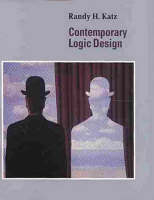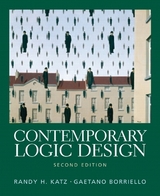
Contemporary Logic Design
Pearson Education (US) (Verlag)
978-0-8053-2703-8 (ISBN)
- Titel erscheint in neuer Auflage
- Artikel merken
In the past ten years there has been a revolution in the practice of hardware design. Professionals now rely on CAD software, rapid prototyping, and programmable logic devices to streamline the design process. Contemporary Logic Design is the first text to address these changes and offer a truly modern introduction to logic design. From the first chapter, the author complements his presentation of logic design theory with discussions of current design technologies.
The book provides comprehensive coverage of programmable logic, including ROMs, PALs, and PLAs. A Practical Matters section concludes most chapters, which ties theory to practice and explains design technologies in detail. To synthesize the text coverage of combinational and sequential design methods, the author uses a detailed case study of a simple processor design in the final two chapters.
The text introduces readers to a wide range of software tools, including schematic capture, logic simulation and Boolean minimization, and dem-onstrates how they fit into the hardware design process. The author also encourages hands-on experimentation with software tools such as LogicWorks to bolster the reader's understanding of practical design methods.
Randy Katz is a Professor of Electrical Engineering and Computer Science at the University of California, Berkeley. He recently received a Distinguished Teaching Award for his contributions to engineering education, and he is coinvestigator on a multicampus NSF-sponsored project to restructure education. His research interests include I/O controller design and high performance striped disk and tape subsystems. He has served on the White House Technology Task Force andVice President Gore's "Reinventing Government" Task Force.
1. Introduction.
The Process of Design. Digital Hardware Systems. Multiple Representations of a Digital Design Rapid. Electronic System Prototyping.
2. Two-Level Combinational Logic.
Logic Functions and Switches. Gate Logic. Two-Level Simplification. CAD Tools for Simplification. Practical Matters.
3. Multilevel Combinational Logic.
Multilevel Logic. CAD Tools for Multilevel Logic Synthesis. Time Response in Combinational Networks. Hazards/Glitches and How to Avoid Them. Practical Matters.
4. Programmable And Steering Logic.
Programmable Arrays of Logic Gates. Beyond Simple Logic Gates. Combinational Logic. Word Problems. Case Study: A Simple Process Line Control Problem. Case Study: BCD-to-Seven-Segment Display Controller. Case Study: A Logic Function Unit Case Study: An Eight-Input. Barrel Shifter.
5. Arithmetic Circuits.
Number Systems. Networks for Binary Addition. Arithmetic Logic Unit Design. BCD Addition. Combinational Multiplier Case Study: An 8 by 8 Bit Multiplier.
6. Sequential Logic Design.
Sequential Switching Networks. Timing Methodologies. Realizing Circuits with Different Kinds of Flip-Flops. Metastability and Asynchronous Inputs. Self- Timed and Speed-Independent Circuits. Practical Matters.
7. Sequential Logic.
Case Studies Kinds of Registers and Counters. Counter Design Procedure. Self-Starting Counters. Implementation with Different Kinds of Flip-Flops. Asynchronous Versus Synchronous Counters. Random Access Memories.
8. Finite State Machine Design.
The Concept of the State Machine. Basic Design Approach. Alternative State Machine Representations. Moore and Mealy Machine Design Procedure. Finite State Machine Word Problems.
9. Finite State Machine Optimization.
Motivation for Optimization State. Minimization/Reduction State Assignment. Choice of Flip-Flops. Finite State Machine Partitioning.
10. Finite State Machine Implementation.
FSM Design with Programmable Logic. FSM Design with Counters. FSM Design with More Sophisticated Programmable Logic. Devices. Case Study: Traffic Light Controller.
11. Computer Organization.
Structure of a Computer. Busing Strategies. Finite State Machines for Simple CPUs.
12. Controller Implementation.
Random Logic. Time State (Divide & Conquer). Jump Counter Branch Sequencers. Microprogramming.
Appendix A: Number Systems.
Appendix B: Basic Electronic Components.
| Erscheint lt. Verlag | 27.10.1993 |
|---|---|
| Verlagsort | Upper Saddle River |
| Sprache | englisch |
| Maße | 208 x 235 mm |
| Gewicht | 1388 g |
| Themenwelt | Mathematik / Informatik ► Informatik ► Theorie / Studium |
| Informatik ► Weitere Themen ► CAD-Programme | |
| ISBN-10 | 0-8053-2703-7 / 0805327037 |
| ISBN-13 | 978-0-8053-2703-8 / 9780805327038 |
| Zustand | Neuware |
| Haben Sie eine Frage zum Produkt? |
aus dem Bereich



